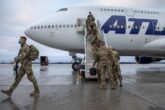August 10, 2017
Afghanistan Has No Silver Bullet
Last week, NBC News reported that President Donald Trump laced into top military leaders in mid-July over U.S. strategy and performance in Afghanistan. He refused to sign off on the plan they finally approved after months of Afghan policy debates that were intended to culminate in a new strategy by May. Trump’s refusal was not a bolt out of the blue. According to the Washington Post, in meeting after meeting this spring and summer, Trump repeatedly pummeled his national security advisor, H. R. McMaster, with two questions: why wasn’t the U.S. military winning in Afghanistan; and why was the United States still stuck there after 16 years?
The president is right to demand answers, as others have noted, especially given the military’s mixed performance over the past 16 years and the paucity of good options for the future. Trump is on much shakier ground when it comes to his reported fuming about NATO contributions, musing about the possible extraction of precious metals from Afghanistan, and demands to know why the United States has not made more progress in the six months of combat since he took office. The president also faces challenges of his own making because he wants to win in Afghanistan and be tough on terrorism, while simultaneously retreating from costly commitments.
At the height of Afghan review season when there is no shortage of worthwhile pieces proposing a variety of strategies, it is helpful to step back and remember that every option entails risk. It’s the job of the president’s national security advisors to recommend where he accept risk and to be clear about the potential consequences. But ultimately it is Trump who needs to pick a lane. There are no silver bullets. That includes sub-contracting the war effort to private militaries – an idea that is far worse than any of the following options, even with all the risks and faults they entail.
Smart Investment or Self-Licking Ice Cream Cone?
Trump was largely silent about Afghanistan until recently. When he finally commented publicly on the war-torn country, it was to say, “I want to find out why we’ve been there for 17 years.” It’s a fair question.
The short answer, and the one that is the most relevant for this president, is protecting the U.S. homeland from a terrorist attack. Resolute Support, the NATO-led mission that supports the Afghan government and that would receive a troop increase, is separate from the U.S. counterterrorism mission. This latter effort consists of 2,100 special operations troops who cooperate with Afghan commandos to target members of the Islamic State affiliate (IS in Khorasan Province or ISKP) and other international fighters. Together, U.S. and Afghan forces have made great strides in this effort. It’s possible that the ISKP could be essentially wiped out in Afghanistan by next year. Al Qaeda already has been seriously degraded in the region. In short, very soon there may be no terrorist groups with the intent and capability to use Afghanistan to strike the United States.
Maintaining U.S. forces in Afghanistan is either a sensible investment or a self-licking ice cream cone. Either way, Trump faces a choice that is rife with risk.
Here’s the catch: experts worry if all U.S. forces withdrew from Afghanistan it could create space for these groups to regenerate or new ones with international attack capabilities to emerge. Keeping only a small counterterrorism force in the country would seem like a potentially sensible solution considering the failure to stabilize the country or beat the Taliban badly enough that it sues for peace. The problem with this approach is that unless the United States can find a way to execute its counterterrorism mission without a friendly government in Kabul, then it cannot separate the two. In other words, if the Resolute Support mission ends or fails to prevent Afghan state collapse it could hamper a narrow U.S. counterterrorism mission.
Depending on how one sees these threats, maintaining U.S. forces in Afghanistan is either a sensible investment or a self-licking ice cream cone. Either way, Trump faces a choice that is rife with risk. And if he decides to keep troops in Afghanistan, then he faces another set of unappealing options.
No Easy Way Out
At the risk of overgeneralizing and excluding unrealistic plans to decisively defeat the Taliban or nonsensical ones to outsource the war to mercenaries, it is possible to identify at least three different pathways forward. All of them come with risks.
Option 1: Aim for reconciliation from a position of strength.
In this scenario, the Taliban and its Pakistani sponsors would capitulate, thereby allowing enabling the United States and Afghan government to dictate the terms of any political settlement. Presumably, this would enable the United States to maintain a counterterrorism force and possibly military bases too.
This is the option that McMaster and Resolute Support planners favor and so merits the most attention. It requires making real military gains against the Taliban in Afghanistan, increasing host nation legitimacy, and coercing Pakistan to reduce its support for the movement. Planners may hope to accomplish this by the end of Trump’s first term, but in practice these three pillars collectively necessitate that the United States commit to open-ended presence in order to demonstrate American resolve.
The military component calls for a modest increase of several thousand as part of a four-year plan to support Afghan security forces so they can defend the country alone. The additional troops would bring with them more air support, troop transport, intelligence, and medevac capabilities to support the Afghan special operations forces, which are doing the bulk of the fighting to retake territory and are set to double in size. U.S. and NATO planners intend for the trainers and advisers to work directly with Afghan troops and officers in lower-level units. They also aim to increase the regular army’s effectiveness as a holding force once territory is retaken and to help with defense institution building. This requires reforming the military leadership and combatting corruption among other things.
Holding territory depends on more than improving regular army forces, which heretofore have proven unable to do so. It also requires increasing the legitimacy of the Afghan government, which is weak, corrupt, riven by political and ethnic rivalries, and unable to deliver social services or create jobs. The components of the U.S. political strategy are unclear, although the thrust appears to be to bolster Afghan President Ashraf Ghani, whose popularity has plummeted, so that he can ram through needed reforms.
Finally, as many experts have observed, the Taliban is unlikely to sue for peace as long as its leaderships enjoys sanctuary in Pakistan. The Pakistan military and intelligence services are also likely to attempt to spoil any potential settlement they consider disadvantageous to their country’s interests. Thus, coercing Pakistan to reduce its support for the Taliban-led insurgency is critical for this option to work. Designating Pakistan a state sponsor of terrorism, imposing other sanctions on individuals in the military and intelligence services, and increasing the use of drone strikes or commando raids against Taliban leaders outside the Federally Administered Tribal Areas have all been mooted as potential coercive instruments to employ.
The most glaring risk is that this scenario may be unrealistic. Even if the Afghan special forces can clear territory, the Afghan army may not be able to hold it. Experts are also skeptical whether the Afghan government can implement the reforms necessary to increase host national legitimacy. And the United States may struggle to bring sufficient pressure to bear on Pakistan to get it to stop providing the Taliban-led insurgency with sanctuary and other support. If any of these three pillars fails to develop as needed, the whole approach could collapse.
Attempting to execute this strategy also comes with other risks. First, attempts to coerce Pakistan could lead it to retaliate, contributing to an escalation spiral with a nuclear-armed country that sponsors various terrorist groups and views the Afghan endgame in nearly existential terms. Access to Pakistani air space also remains critical for operations in Afghanistan. The administration must be prepared for Pakistan to punch back. Second, this approach does not address the moral hazard problem, wherein Afghan elites continue to avoid the costs of their bad behavior. Third, putting more troops into Afghan risks inviting even greater support for the Taliban from Russia and Iran, both of which oppose a long-term U.S. military presence.
Option 2: Aggressively pursue a political settlement immediately.
In this scenario, the United States would be much more forward leaning about getting to the negotiating table and be prepared to make bigger concessions once there. These might include pressing the Afghan government to accept a power sharing agreement and closing down U.S. bases. The administration might attempt to make keeping a limited counterterrorism force based out of the embassy its red line, but would need to be prepared for the Taliban to balk.
This option requires putting military pressure on the Taliban while simultaneously pursuing a more robust diplomatic strategy to get its leaders to agree on talks sooner rather than later. In other words, any military strategy is designed to get the Taliban to the table and achieve a minimally acceptable settlement for the United States, vice ensuring the strongest possible negotiating position for U.S. and Afghan governments once talks get underway.
Political pressure on Afghan elites would be more focused on getting them to negotiate, rather than on promoting reforms. The United States also would need to employ limited coercive measures against Pakistan to convince it to play a constructive role in getting the Taliban to negotiate, while simultaneously ensuring that Pakistani interests in Afghanistan were accounted for. And U.S. diplomats would need to engage China, Iran, and Russia, all of which want a political settlement, although not necessarily one that is favorable to the United States.
There is an obvious risk that telegraphing desire to get a deal quickly signals desperation, especially when the Taliban is going from strength-to-strength on the battlefield. The Taliban may not negotiate if they believe time is on their side and it is unclear whether Pakistan could or would compel them to. An ongoing or enhanced U.S. military commitment intended to pressure Taliban leaders to the table could still result in a quagmire or simply delay a precipitous withdrawal. Because this approach places the U.S. and Afghan government in a weaker negotiating position, it also risks prematurely throwing away hard-fought gains. Post-settlement conditions in Afghanistan could deteriorate as result, creating space for international terrorist groups to regenerate and imperiling any U.S. counterterrorism force still present in the country. Additionally, this options risks decreasing U.S. influence in Afghanistan and the wider region and damaging American prestige.
Option 3: Play for time.
Kicking the can down the road is never a popular option and is unlikely to appeal to a president who wants to win or go home. Nevertheless, it has been mooted in various forums and so merits consideration.
In this scenario, the United States would focus on propping up the Afghan government until U.S. decisionmakers feel comfortable terrorists won’t be able to return. The United States would continue promoting political reforms and might still get tougher with Pakistan. But this option would not require major governance reforms in Afghanistan or coercing Pakistan into ending its support for Taliban-led insurgency. It also does not necessitate an aggressive diplomatic strategy from the Trump administration.
The most obvious risk associated with this option is not only that it indefinitely commits the United States to a war effort that costs billions annually and continues to claim the lives of American and NATO forces, but also that it abdicates any attempts at controlling the outcome. Politically, this may not be sellable or sustainable. Moreover, conditions in Afghanistan could deteriorate further, putting U.S. forces at greater risk. The longer these forces are in the region, the higher the chances of a confrontation with other regional actors that support the Taliban.
Welcome to the Suck
None of these options is appealing. All carry risk. There is always a straw-man element to this type of exercise. There are other options the administration could consider. It could also adopt a goldilocks approach that mixes elements from the various elements above. For example, charting a middle ground between racing to the negotiating table and hoping to beat the Taliban into submission may be the most acceptable compromise. This would require not only talking and fighting at the same time, but also taking greater ownership of the peace process. Whatever approach the administration takes it must clarify its minimal acceptable outcome in Afghanistan and be clear about where it is willing to tolerate risk. And then Trump needs to articulate this to the American people. He can blame the previous administration and vent about inheriting a mess in Afghanistan. Like conducting Afghan reviews, that’s becoming something of a tradition. But ultimately he must own his decision and the risks that inevitably will come with it.
More from CNAS
-
A Failure to Plan: Examining the Biden Administration’s Preparation for the Afghanistan Withdrawal
Afghanistan, Iraq, and Vietnam. One failure is a horrible accident; two failures are a tragic coincidence; three failures are a disturbing trend that shows the U.S. government...
By Christopher D. Kolenda
-
Against All Odds
Eighteen months after taking power, the Taliban is intensifying its repression of Afghan civil society and cracking down on the rights and freedoms of all Afghans, especially ...
By Lisa Curtis, Annie Pforzheimer & Jan Mohammad Jahid
-
To Help Afghanistan, Engage Its Political Opposition
The effort to help Afghans shape a better alternative should begin now....
By Richard Fontaine & Lisa Curtis
-
International Community Must Do More to Protect Human Rights in Afghanistan
Human rights in Afghanistan, especially those of women and girls, have deteriorated sharply during the first year of Taliban rule. The very real prospect of losing a generatio...
By Lisa Curtis, Annie Pforzheimer & Jan Mohammad Jahid



